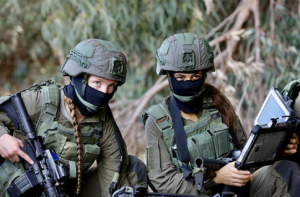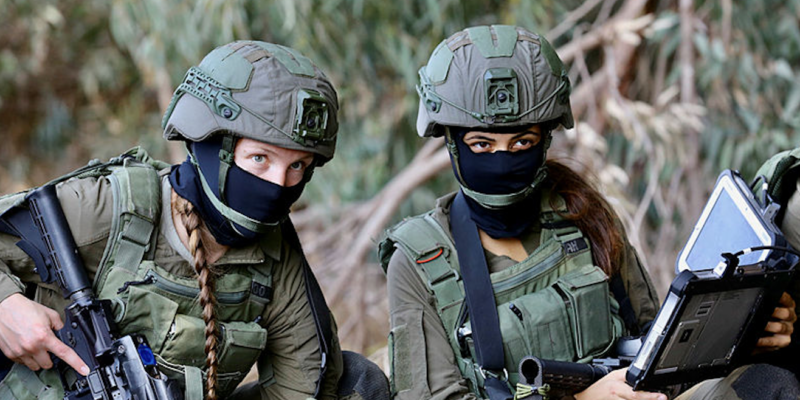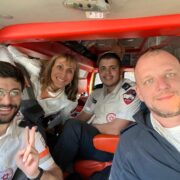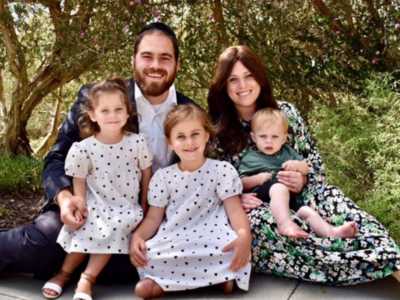 By Yoav Limor and Hila Timor Ashur, Israel Hayom via JNS.org
By Yoav Limor and Hila Timor Ashur, Israel Hayom via JNS.org
Some four years ago, in typical secrecy, the Israel Defense Forces’ infamous Unit 8200 established its first company of female warriors. The company operates within the framework of 8200’s combat intelligence unit, which meshes infantry and technology to form the IDF Intelligence Directorate’s reconnaissance outfit. Unlike other combat units in the army, the soldiers in this company are first and foremost tech wizards. This is also how they are recruited: Their technological proficiency is tested first, and only then their physical acumen and fitness as combatants.
“We recruit the male and female fighters of the highest caliber, who are also at the highest level technologically,” said Lt. Col. D (36), who has commanded the unit for several months.
The combat intelligence unit is 8200’s forward operating arm, and it can reach places keyboard warriors can’t. The soldiers don’t just bring the technology to the front, they also operate it. Inside enemy territory, or close to it, they are tasked with accomplishing what developers and programmers cannot do from afar.
Theoretically, this era is a technological Garden of Eden. Everyone has a computer, everyone uses the Internet and sends emails. Everyone has a cell phone, Facebook, WhatsApp. All these create a never-ending flow of information. An attacker only need develop the tools and methods to gather and analyze this information.
The reality, of course, is far less simple. First, you need to gather the information. Conversations on WhatsApp, for example, are encrypted. Apple software, meanwhile (unlike Android) is not open-source. Very few countries are capable of bypassing such barriers without leaving a fingerprint.
Second, you need the ability to sift through the information. In the past, the brunt of information was via signals intelligence, or SIGINT (or, in simple English, wiretaps). 8200 eavesdropped on phone calls, and the important information was kicked up the priority list. This works on a small scale, but anyone wanting to compile hundreds of millions of emails, personal messages and other sources of information per day needs super-systems capable of storing and automatically analyzing the data.
Third, and most importantly, the enemy is also learning. Whether in terms of collecting information in the cyber sphere — an area in which Iran is particularly active, but also where Hamas is showing surprising and methodical advancement — and in terms of defending against Israeli activity, through upgraded systems and tighter security measures. Most terrorist elements (in Gaza, Judea and Samaria and Lebanon) have understood that Israel is a technological superpower, and long ago transitioned to communicating via alternative means. They don’t allow cell phones in meetings, knowing their microphones or cameras can be remotely activated, avoid sending electronic messages or mail, and often use codewords.
“We are more exposed than the average IDF soldier to these capabilities of our enemies,” says Lt. Col. D. “The information security component has become dramatic for them. It obligates us to protect ourselves and to safeguard our operational methods and technology, so it stays a secret, and at the same time find breaches on the other side and exploit them.”
All of these defenses are very difficult, and sometimes impossible, to bypass remotely; hence the need to make physical contact with the enemy. On his home turf, in his home and sometimes even up close and personal. The unit does its work in the field — this can be a sleepy Palestinian village in the dead of night, but also enemy territory. The unit’s soldiers operate across all arenas, in all environments. Consequently, a great deal of planning and study is required before each mission, to adapt the operational methods to the conditions on the ground.
Sometimes the mission is to install a device, other times to remove a device, and occasionally it’s decrypting something in the field to collect data in real-time. Each mission requires a different operational solution, which is sometimes tailor-made for the unit and on a one-time basis. There is no such thing as a defined operational protocol because no two missions are the same. The soldiers must adapt themselves to each mission—a far cry from the concept employed by many IDF units.
The unit’s advantage is its parent unit, 8200, which is divided into departments, each with a specialized focus, mostly pertaining to the cyber sphere. The combat intelligence unit works closely with all these departments on a daily basis, which allows it to find the solutions it needs to its various problems.
It is essentially a boutique unit which performs missions and provides solutions that other units or tools cannot. The more the enemy improves and advances technologically, the greater the demand for these solutions.
“Our fighters need to know these technologies very thoroughly because they are often required to make decisions or provide solutions in the field,” said Lt. Col. D.
In many cases, what isn’t done in real time will never be done, because the enemy will have destroyed evidence or disappeared. Even if not, it’s doubtful the IDF will go to the same place twice. Therefore, the here-and-now aspect of the mission is critical.
Identify, Sort, Verify
8200’s combat unit was established several decades ago as a reserve battalion, becoming part of the regular army in 2011. Today, too, its reservists serve in a combat capacity and participate in quite a few operations. Over the years the unit has undergone changes and adaptations, based on the changing environment and technology. The soldiers, including now female ones as well, operate at any time of day or night, in any terrain.
Although the unit belongs to 8200, it works in conjunction with all of Israel’s security and intelligence agencies. In other words, any client of the mother unit, 8200, is also a client of its combat unit.
In recent years, 8200 has found it increasingly difficult to recruit new soldiers to its combat unit. Although it is first in the recruitment line ahead of all other units in the IDF (except for the pilot’s course), it isn’t easy finding boys with the requisite technological aptitude who also want to serve in a combat capacity in the unit. Those who choose to be fighters prefer to join special forces or combat battalions, and those who opt to serve in a technological capacity, despite meeting the physical criteria for a combat profile, would rather sit in an office writing code.
To contend with this challenge, the unit has devised several solutions. The first is exposure. While secrecy is good for business, it’s bad for recruitment. The youngsters, as stated, choose units they’re familiar with and have heard about. Sayeret Matkal, the IDF’s top special forces unit, and Shaldag (“Kingfisher”), the Israeli Air Force commando unit, are secretive, but over the years have been the focus of countless reports, books and movies, and their operational legacy is robust and attractive to young men in search of action.
8200’s combat unit is young and anonymous. To overcome this hurdle, the decision was made eight years ago to reveal its existence. At the time there were no female fighters in the unit, which was created as a result of the lessons learned from the Second Intifada and operations in Gaza, and the need to surmount the obstacles Israel’s enemies pose to the IDF in general and to 8200 in particular.
The increasing need for high-caliber manpower led to the second decision, made in 2017, to recruit women into the unit. This path was paved, first and foremost, by the success of women in other combat units in the IDF: Around 50 percent of the army’s air-defense controllers and the Home Front Command’s search and rescue battalions (which perform the brunt of routine operations in Judea and Samaria) are women, and this is also the case in the mixed-gender battalions that defend the borders—Caracal, Lions of the Jordan and Bardelas.
This success led to more and more women seeking service in a combat capacity. Today, the demand among female recruits for positions in the field is extremely high. The most sought after position, as usual, is instructor — but combat positions aren’t lagging far behind. Some of the women who possess the requisite technical skills lack the physical profile for combat duty, or the motivation (unlike men, Israeli women must ask to serve in a combat role), and some would rather serve in more prominent units and capacities.
This amplifies the challenge facing the unit even more: Find the women with talent, sort through them, make sure they want to be combat soldiers and then put them through a doubly arduous training process: technological and combat. Only several dozen women have completed this training since the unit opened its doors to women.
Even if you look closely, you won’t find the role of “8200 combat intelligence” on the list of available positions for women in the army’s brochures. Nor will you find it on the Meitav website, which provides information to young men and women prior to enlistment.
Female recruits with the potential to serve in the unit are tapped due to their high “Quality Group” score (which summarizes the results from personal interviews and computer-generated psycho-technical test results) and tend to be graduates of science-oriented tracks in high school. Some of them reach the unit after being dropped from other prestigious courses, such as pilot’s course and the naval academy course.
This is also why the Military Intelligence Directorate chose to participate in this article: To let female recruits know about the unit and encourage them to join its ranks—and if they are contacted, not to reject it outright.
“I view this article as a great opportunity,” said Lt. Col. D. “Not that we have demand problems, but an article like this can open the minds of many women who interview for the Military Intelligence Directorate, even those who never considered combat service and want to reach 8200.”
“Technological warriors,” he calls them. From his perspective, “the combat aspect is the DNA of the role. Initially, their integration was a challenge, but it very quickly got on track. Their motivation to prove themselves is enormous. They are pioneers. And they have many advantages compared to men, which produces impressive operational results.”
Women fighters at this age, he explained, “are more mature decision-makers than their male counterparts. In our line of work, maturity and sound judgment are important, because the price of a mistake is dramatic.”
Although the female company works separately from the male one, the unit makes sure each mission is assigned to the soldiers most suited to it skills-wise. Hence the women must be prepared for any type of mission on any front. Both companies, male and female, work simultaneously, and when the need arises go on joint missions. That said, women represent just 15 percent of all the soldiers in the unit.
One criterion for selecting a soldier for a given mission is physical. For missions involving very long marches with heavy equipment, for example, male soldiers will almost always be selected. Conversely, women are better suited for other missions.
The degree of danger, they say in the unit, is not a factor. It is, after all, a combat unit that operates behind enemy lines.
“On the modern battlefield, you need more than a grenade or a rifle,” said Lt. Col. D. “It used to be infantry against infantry or tanks against tanks. Today, the technology comes with tremendous advantages. The female warriors will be part of any battle plan in a future war. Our only consideration will be professional, not based on gender.”
In most cases, missions assigned to female soldiers require a prolonged preparation period. Only a handful of missions are spur of the moment. This is because these missions are usually technologically complex and require meticulous planning.
What normally happens is the female warriors receive an operational objective, after which they dismantle the problem and begin the process of intensive study. They then devise a specific and unique solution, based on the unit’s comprehensive operational and technological toolbox. These preparations can last for months and on some occasions entail mock-ups of the target.
The soldiers of 8200 are actively involved in the planning process.
“In the IDF, the person who developed the Merkava tank is not the person teaching others how to shoot with it,” said a senior unit officer. “Here, that’s not the case. The person who developed the most advanced technology in the world also teaches us and is also involved in the process during the operation, because every intelligence-related question has a technological answer that needs developing.”
“8200 comes with a problem, and we come with a solution to that problem,” said Capt. A, the commander of the unit’s female company. “Every mission is different than the one before it—the chances of doing a mission we’ve already done is close to zero. This means every soldier must stretch herself to her limits and beyond, and open a train of thought for something that is infinite. We are the operational arm of 8200. That’s nothing less than the best.”
Lt. Col. D added: “Our mission diversity is immense. I don’t think there’s another unit in the army with such a broad operational spectrum.”
Note: This article has been trimmed to meet space constrictions. To read the full interview, visit jns.org.










Comments